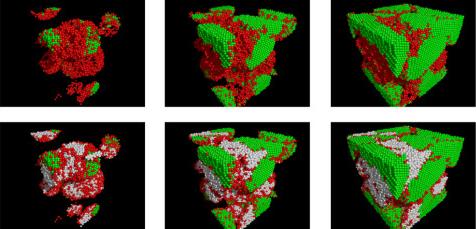
Frigyes Podmaniczky1, Gyula Tóth2, György Tegze1, Tamás Pusztai1, László Gránásy1,3
1Institute for Solid State Physics and Optics, Wigner Research Centre for Physics, P.O. Box 49, Budapest H-1525, Hungary
2Department of Mathematical Sciences, Loughborough University, Loughborough, Leicestershire, LE11 3TU, U.K.
3BCAST, Brunel University, Uxbridge, Middlesex, UB8 3PH, United Kingdom
We review recent advances made in modeling heteroepitaxy, two-step nucleation, and nucleation at the growth front within the framework of a simple dynamical density functional theory, the Phase-Field Crystal (PFC) model. The crystalline substrate is represented by spatially confined periodic potentials. We investigate the misfit dependence of the critical thickness in the StranskiKrastanov growth mode in isothermal studies. Apparently, the simulation results for stress release via the misfit dislocations fit better to the PeopleBean model than to the one by Matthews and Blakeslee. Next, we investigate structural aspects of two-step crystal nucleation at high undercoolings, where an amorphous precursor forms in the first stage. Finally, we present results for the formation of new grains at the solid-liquid interface at high supersaturations/supercoolings, a phenomenon termed Growth Front Nucleation (GFN). Results obtained with diffusive dynamics (applicable to colloids) and with a hydrodynamic extension of the PFC theory (HPFC, developed for simple liquids) will be compared. The HPFC simulations indicate two possible mechanisms for GFN.


